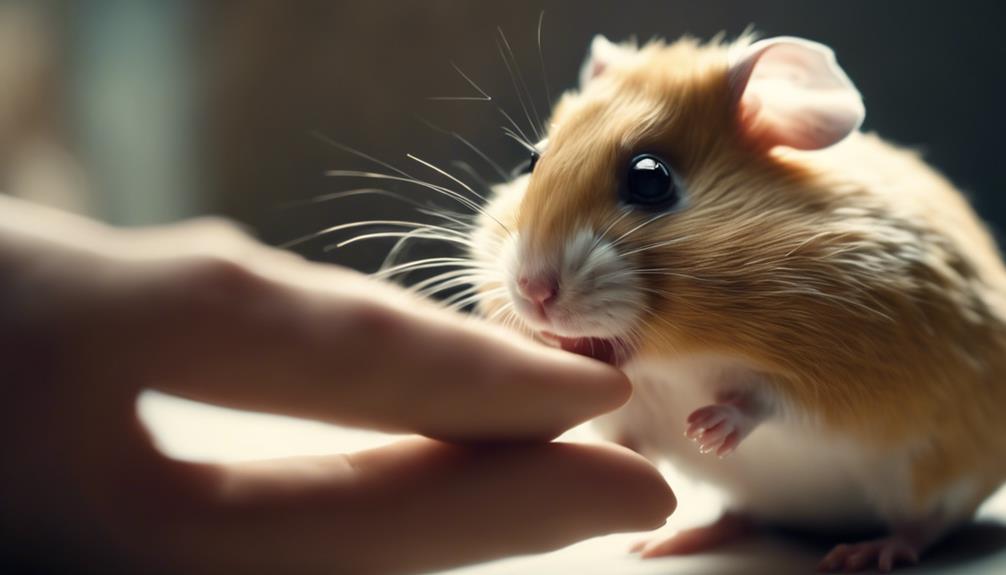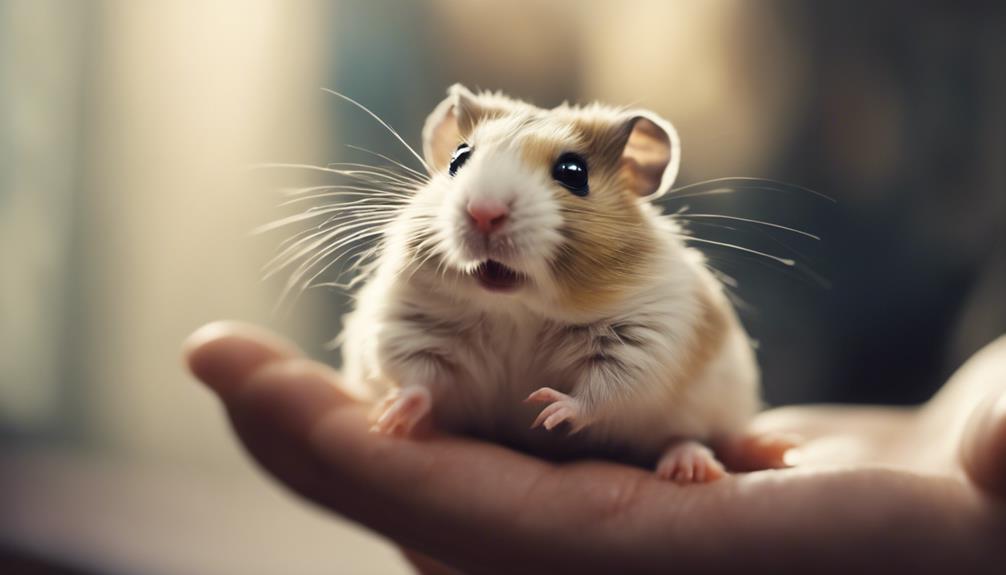Do Hamsters Recognize Their Owners? Exploring Their Memory and Bonding

Yes, hamsters can recognize their owners through subtle cues in behavior and displays of affection.
Their memory and bonding capabilities contribute to the intricate dance of their relationships with humans.
Hamsters' Memory Span
In observing hamsters, it becomes evident that their memory span is surprisingly extensive, allowing them to form lasting connections with their owners. Hamsters exhibit remarkable memory retention capabilities, recalling familiar scents, sounds, and even the presence of their human companions. Through simple recall exercises, such as offering treats or engaging in interactive play, hamsters can reinforce their recognition of their owners, fostering a bond built on trust and familiarity.
Their ability to retain memories of positive interactions contributes to the development of a strong emotional connection with their caregivers. By engaging in consistent and gentle interactions, owners can further enhance their hamsters' memory retention, solidifying the foundation of their relationship. These recall exercises not only stimulate the hamsters' cognitive functions but also serve as a means of strengthening the rapport between the pet and its owner.
In essence, the memory span of hamsters plays a vital role in their capacity to recognize and form lasting bonds with their owners, emphasizing the significance of positive reinforcement and consistent interaction in nurturing these relationships.
Human Recognition Abilities
Humans possess remarkable recognition abilities, often forming strong bonds with those they're familiar with. The importance of these connections lies in the inherent memory of familiarity, where individuals can distinguish between known and unknown faces.
Understanding human recognition abilities sheds light on the significance of personal relationships and the impact they've on our daily interactions.
Owner Bond Importance
With a keen sense of recognition abilities, humans naturally form strong bonds with their pet hamsters, emphasizing the importance of the owner-hamster relationship. Trust building and emotional connection are foundational aspects of this bond. The reciprocity of care and attention between owner and hamster fosters a deep connection that transcends mere companionship.
Owners who invest time and effort into understanding their hamsters' needs and behaviors often find themselves rewarded with loyal and affectionate companions. This bond goes beyond mere recognition; it's a testament to the capacity for empathy and understanding that exists between different species.
The owner's role in nurturing this relationship is paramount, as it sets the foundation for a harmonious and fulfilling companionship that both parties cherish.
Memory of Familiarity
The intricate bond between owners and their hamsters highlights the remarkable memory of familiarity displayed by humans in recognizing their beloved pets. Familiarity recognition and cognitive abilities play a significant role in this bond, allowing for a deep understanding between the two beings.
Emotional attachment further solidifies this connection, creating a sense of trust and comfort that transcends mere recognition. Memory retention also contributes to this bond, as both the human and the hamster can recall past interactions, building upon their relationship over time.
Through these cognitive processes, a unique and enduring bond forms, showcasing the capacity for connection and empathy between different species.
Bonding With Hamster Behavior

Establishing a deep connection with a hamster hinges on observing and understanding their unique behaviors and responses. Playtime habits are crucial in fostering a bond with these small pets. Hamsters enjoy exploring their surroundings and engaging in activities that stimulate their curiosity. By providing them with safe toys and interactive environments, owners can encourage playfulness and strengthen their relationship with these adorable creatures.
Furthermore, comfort seeking behaviors play a significant role in bonding with hamsters. These tiny animals have specific preferences for nesting materials and bedding, which can provide them with a sense of security and familiarity. By paying attention to their choices and creating a cozy habitat, owners can show their hamsters that they care about their well-being.
Social Interaction Patterns
In the intricate dance of hamster-human relationships, understanding their social interaction patterns is key to nurturing a deep bond with these delightful creatures. Hamsters communicate through subtle social cues and respond to various behavioral stimuli, creating a unique language that builds the foundation of their interactions with humans.
Here are three insights into the social interaction patterns of hamsters:
- Body Language: Hamsters use body postures, facial expressions, and vocalizations to convey their feelings and intentions. Understanding these cues can help interpret their moods and needs accurately.
- Scent Marking: Hamsters have scent glands that they use to mark their territory and communicate with others. Recognizing the significance of scent marking can enhance the understanding of their social dynamics.
- Play Behavior: Play is an essential part of hamster social interactions. Observing their play habits can provide valuable insights into their personalities and preferences, fostering a deeper connection between humans and their furry companions.
Training and Familiarity

As hamsters showcase their social interaction patterns through subtle cues, discovering the nuances of training and familiarity with these small companions unfolds a new dimension in their dynamic relationship with humans. Training techniques play a crucial role in enhancing the bond between hamsters and their owners. By employing positive reinforcement methods and consistency, hamsters can learn various commands and behaviors, showcasing their recall abilities. Through the habituation process, hamsters become more accustomed to their owners' presence and touch, further solidifying the bond between them.
Recognition cues also play a vital role in the training and familiarity of hamsters with their owners. These cues can range from scent recognition to specific sounds or visual signals that the hamster associates with their owner. By consistently using these recognition cues during interactions, owners can strengthen the bond and trust with their furry companions.
In essence, training and familiarity are key components in nurturing a positive relationship between hamsters and their owners, fostering understanding and companionship in this unique dynamic.
Cognitive Studies on Hamsters
Delving into cognitive studies on hamsters reveals the intricate workings of their minds, shedding light on their intelligence and problem-solving abilities. These tiny creatures possess remarkable cognitive abilities that often surprise researchers and pet owners alike.
Here are some intriguing findings from cognitive studies on hamsters:
- Memory Retention: Studies have shown that hamsters exhibit impressive memory retention capabilities, especially when it comes to remembering pathways in mazes or the location of food sources. This suggests a level of cognitive complexity that's quite fascinating for such small animals.
- Problem-Solving Skills: Cognitive studies have also demonstrated that hamsters possess notable problem-solving skills. They can navigate through complex mazes, solve puzzles to access rewards, and even exhibit a degree of strategic thinking in certain situations. This showcases their cognitive adaptability and intelligence.
- Learning Abilities: Hamsters have been observed to learn new tasks relatively quickly, indicating a capacity for learning and adapting to changing environments. Their cognitive flexibility allows them to adjust their behaviors based on past experiences, highlighting their learning prowess.
Emotional Responses to Owners

In the realm of emotional responses to their owners, hamsters showcase a remarkable ability to recognize their owner's scent. This recognition often results in heartwarming displays of joy, where the little creatures may exhibit signs of happiness through playful behavior or audible squeaks.
Moreover, hamsters are known to actively seek out their owner's attention, showcasing a deep bond that goes beyond mere recognition.
Owner's Scent Recognition
With a keen sense of smell, hamsters swiftly recognize their owners' unique scent, often eliciting heartwarming emotional responses. This deep-rooted association between scent and memory helps hamsters recall familiar faces and create strong bonding cues with their beloved owners.
Here are three key points to consider:
- Comfort and Security: The comforting scent of their owner can provide hamsters with a sense of security and safety, promoting a positive emotional state.
- Trust and Bonding: By recognizing their owner's scent, hamsters establish a bond built on trust, familiarity, and affection, enhancing the human-animal relationship.
- Emotional Well-being: The ability to detect and respond to their owner's scent contributes to the emotional well-being of hamsters, fostering a sense of belonging and love in their little hearts.
Expressing Joy Towards Owner
Recognizing their owner's presence, hamsters often exhibit delightful displays of joy, showcasing their deep emotional connection through endearing gestures and expressions. Hamsters engage in joyful interactions with their owners, conveying their happiness through subtle body language cues such as wagging their tails, perking up their ears, and even performing gentle grooming behaviors. Additionally, these small pets express their joy vocally, emitting soft squeaks or chirps that signify their excitement and contentment. Furthermore, hamsters engage in playful behaviors like running in circles, hopping around, or even engaging in friendly nibbling as a way to show their affection and bond with their beloved human companions.
| Joyful Interactions | Body Language Cues |
|---|---|
| Vocal Expressions | Playful Behaviors |
Seeking Owner's Attention
Seeking the attention of their owners, hamsters display a range of emotional responses that highlight their strong bond and affection towards their human companions. These small creatures often engage in playful gestures to capture their owner's focus, showcasing their desire for interaction and connection.
Whether through gentle nibbling on fingers, climbing onto hands, or excitedly running in circles around their owner, hamsters exhibit behaviors that demonstrate their yearning for engagement. By seeking attention in these endearing ways, hamsters not only express their attachment but also establish a deeper sense of trust and companionship with those who care for them.
In these moments of seeking attention, hamsters reveal the depth of their emotional connection, enriching the bond they share with their owners.
Long-Term Relationship Dynamics

Over time, hamsters develop unique and endearing relationship dynamics with their dedicated owners, showcasing the depth of their bond through subtle gestures and behaviors. As trust builds between a hamster and its owner, the communication cues become more refined, leading to a harmonious and enriching long-term relationship.
| Relationship Dynamics | Description |
|---|---|
| Trust Building | Hamsters exhibit trust by approaching the owner without fear, eating from their hand, and seeking comfort in their presence. |
| Communication Cues | Through gentle squeaks, grooming behaviors, and responsive movements, hamsters convey their emotions and needs to their owners. |
| Bond Strengthening | Spending quality time together, providing a consistent environment, and responding to their cues enhance the bond between hamster and owner. |
| Mutual Understanding | Owners who observe and learn their hamster's preferences, habits, and body language can establish a deeper connection based on mutual understanding. |
| Emotional Resonance | The emotional resonance between a hamster and its owner deepens over time, fostering a sense of companionship and security for both parties. |
Frequently Asked Questions
Can Hamsters Remember Specific Events or Interactions With Their Owners?
Memory retention in hamsters can surprise many. Their recall abilities may not match humans, but emotional connections are powerful. Trust building with owners can enhance these bonds, showing a depth of understanding beyond expectations.
How Do Hamsters React to Meeting New People Besides Their Owners?
When introduced to new people, hamsters may display cautious behaviors like freezing or hiding. Through gentle socializing techniques and exposure to a new environment with familiar faces, they can gradually build trust and exhibit more relaxed behavioral responses.
Are There Any Specific Behaviors That Indicate a Strong Bond Between a Hamster and Their Owner?
A strong bond between a hamster and their owner is evident through body language cues like seeking proximity and relaxed posture, social grooming, joyful vocalizations, and a positive treat response. These behaviors showcase their deep connection and mutual trust.
Can Hamsters Be Trained to Perform Certain Tasks or Tricks?
In the realm of furry companions, hamsters can surprise with their knack for learning tricks. Through positive reinforcement and patience, these tiny creatures can master tasks, showcasing their cleverness and forming deeper bonds with their owners.
What Are Some Ways to Strengthen the Bond Between a Hamster and Their Owner Over Time?
To strengthen the bond between a hamster and their owner, interactive playtime and enrichment activities are key. Daily handling and positive reinforcement create trust and connection. These actions nurture a fulfilling companionship over time.









